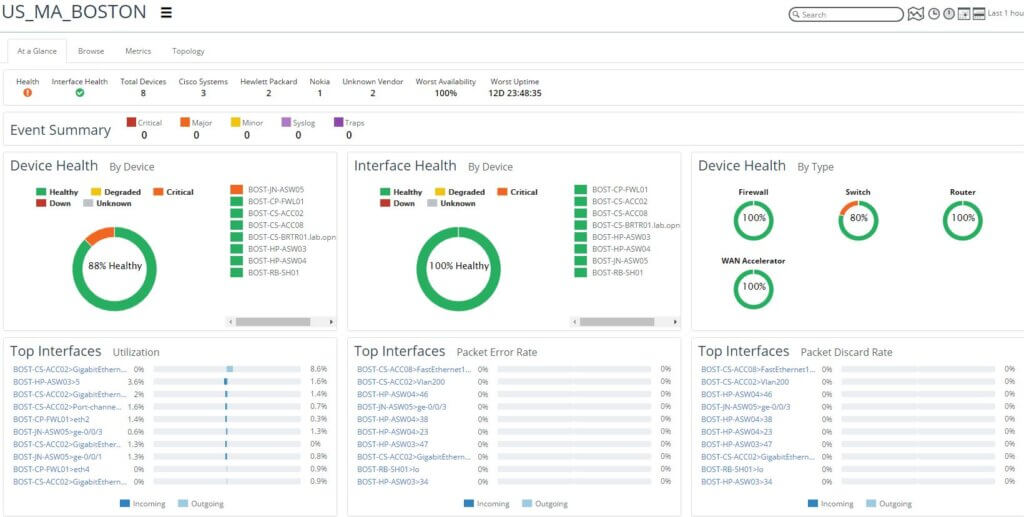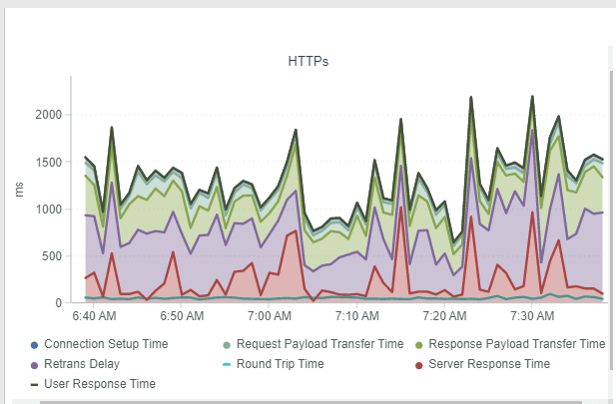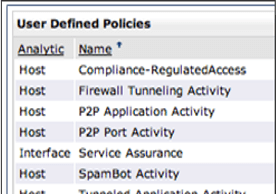Network management is a complex discipline that requires a comprehensive effort to plan, optimize, maintain, and secure enterprise network operations. This starts with understanding all the elements that establish a comprehensive network management strategy.
Network fault management
Network fault monitoring typically involves the deployment of monitoring tools that collect data from network devices in real-time. These tools often use techniques such as SNMP, WMI, streaming telemetry, ping tests, flow analysis, and log analysis to monitor network health and identify faults.
When a fault or anomaly is detected, the monitoring system generates alerts or notifications to network administrators or operators. These alerts provide information about the nature of the fault, its severity, and its potential impact on the network. Network administrators can then take appropriate actions to diagnose and resolve the issue, ensuring the network operates optimally.
Fault management is a critical aspect of network and systems administration that focuses on detecting, diagnosing, and resolving various types of faults or issues that may arise within a system, network, or application. The key capabilities of fault management include:
- Fault Detection and Isolation: The ability to identify deviations from expected behaviors or conditions, then determining the scope and impact of a fault. This involves monitoring various parameters, metrics, and performance indicators to detect anomalies, errors, or failures.
- Root cause Analysis: Identifying the underlying cause of a fault. This involves analyzing metrics and logs to determine the sequence of events that led to the fault and pinpointing the specific component or process responsible.
- Alert Generation: Generating alarms, alerts, or notifications when a fault is detected. These alerts can be in the form of emails, text messages, dashboard indicators, or other notifications to inform administrators or users about the presence of a fault.
- Reporting and Analytics: Generating reports and insights on the frequency, duration, and types of faults that occur. This information can be used for trend analysis, capacity planning, etc.

Configuration management
Network configuration management is the process of monitoring, maintaining, and organizing the information pertaining to your organization’s network devices. It is responsible for the setup and maintenance of network devices along with the installed firmware and software.
The primary goal of configuration management is to confirm that the system’s components work together seamlessly, facilitate efficient, reliable deployment and maintenance processes, and ensure compliance with regulatory standards. Configuration management allows you to quickly configure and replace the functionality of a network device after a failure. If you don’t have a recent backup of that device, you’ll be starting over from scratch to configure new devices.
Key characteristics of configuration management include:
- Network device discovery and diagramming: Having an accurate account of your network inventory and its status is critical to network configuration management. The first step is to map the network elements, including physical, logical, and virtual components, to create a high-definition network diagram. These automated network diagrams highlight new and modified devices, as well as devices with configuration errors.
- Configuration backup: Configuration backup is the process of extracting configuration settings from a device and storing it to disk. The configuration restore process uses backup configuration data files for the system to restore a specific system configuration, whether on that same device or similar devices.
- Configuration change management: Obviously, your network change management solution must be designed to keep track of any changes anyone makes to your devices or systems. This is crucial to avoid any errors or unauthorized changes that might bring about unfavorable consequences. It also speeds the troubleshooting process immensely by automatically comparing before and after configurations and highlighting differences.
- Policy compliance and reporting: Network configuration management helps ensure compliance with regulatory, organizational, and security policies, like FISMA, SOX, HIPAA, PCI, NIST 800-53, SAFE, or DISA STIG. Out-of-the box templates make sure devices and systems are configured correctly to conform to organizational and regulatory policies. Leverage fully customizable rules to validate against a “gold-standard” configuration.
In short, configuration management promotes consistency, helps in identifying and resolving issues more efficiently, and ultimately leads to more stable and reliable systems. Additionally, configuration management can play a crucial role in handling complex configurations and managing dependencies between different components.
Network performance management
Network Observability consists of tools that leverage a combination of data sources to provide a holistic view of how networks are performing. Data sources include network device-generated traffic data (like network flows), raw network packets, and network device health metrics and events.
Network performance management tools provide diagnostic workflows and forensic data to identify the root causes of performance degradations — increasingly through the adoption of advanced technology, such as artificial intelligence (AI) or machine learning algorithms (ML). Based on network-derived performance data, NPM tools provide insight into the quality of the end-user experience.
NPM use cases provide the ability to monitor, diagnose and generate alerts for dynamic end-to-end network service delivery as it relates to digital experience. Key capabilities of network performance management include:

- Monitoring: NPM involves continuous and real-time monitoring of various network parameters such as bandwidth utilization, latency, and packet loss.
- Analysis: After gathering data through monitoring, NPM tools analyze the collected information to identify trends, patterns, and potential performance bottlenecks. This analysis, which typically leverages AI and machine learning, helps IT Operations teams understand the current state of the network and identify areas that need improvement.
- Troubleshooting: When issues arise, NPM allows IT to quickly diagnose and troubleshoot problems. This includes identifying the root causes of performance degradation, locating faulty devices or configurations, and resolving performance bottlenecks.
- Reporting: NPM tools generate comprehensive reports and dashboards that provide insights into network performance over time. These reports help in tracking key performance indicators (KPIs), identifying recurring issues, and measuring the effectiveness of performance improvement measures.
- Capacity Planning: NPM involves planning for future network requirements based on historical performance data. By predicting future demands, organizations can allocate resources more efficiently and avoid unexpected performance issues.
- Security: Network performance management can also supplement network security since poor network performance can be a sign of security breaches or cyberattacks. NPM tools typically include security monitoring features to detect anomalies and potential threats as they cross the network.
In summary, network performance management is a crucial aspect of maintaining a healthy and responsive network infrastructure, ensuring that organizations can meet the demands of their users and applications while maximizing the efficiency of their network resources.
Network security forensics
Network security forensics centers on the discovery and retrieval of information about cyberthreats within a networked environment. Common forensic activities include the capture, recording and analysis of events that occurred on a network to establish the impact and source of cyberattacks.
Investigators use network forensics to examine network traffic data that are involved or suspected of being involved in cyberattack. Security experts will also look for data that points in the direction of data exfiltration, outbound communication with blacklisted IPS, internal reconnaissance, etc. With the help of network forensics, security experts can track down all communications and establish timelines based on network data captured by the network monitoring solutions.

The main objectives of network security are to:
- Prevent unauthorized access: Network security measures are designed to prevent unauthorized individuals or entities from gaining access to sensitive data, systems, and resources. This includes protecting against external attackers as well as unauthorized internal users.
- Protect data integrity and confidentiality: Network security ensures that data remains unaltered and trustworthy during transmission and storage. It prevents unauthorized users from accessing or modifying data in transit or at rest.
- Maintain network availability: Ensuring network availability is essential for maintaining business operations. Network security measures aim to minimize the risk of disruptions and downtime caused by cyberattacks.
Riverbed supports four types of network management
Riverbed offers a complete and integrated portfolio of network management solutions:
- Riverbed NetIM provides fault and configuration management. It leverages SNMP, WMI, streaming telemetry, CLI, synthetic testing, IP SLA metrics, syslog, and traps to monitor and troubleshoot network infrastructure health, availability, and performance. Use NetIM to detect performance issues, map application network paths, diagram your network, identify configuration changes, plan for capacity needs, and troubleshoot infrastructure problems.
- Riverbed NetProfiler provides enterprise-wide network flow monitoring. It supports a wide range of flow types and is used for monitoring bandwidth consumption, top talkers, and network utilization. It also supports discover and dependency mapping, capacity planning, and security forensics.
- Riverbed AppResponse provides real-time packet capture and analysis. In addition to monitoring round trip time, network errors, and bandwidth, AppResponse can also analyze more than 2500 business applications, including web transactions, SQL databases and VoIP and video application performance. Packet capture is also critical to network security forensics.
To learn more about Riverbed’s network management capabilities, please click here.
